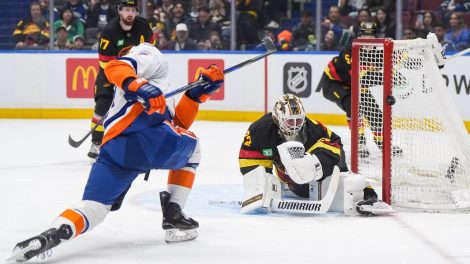What is the trade value of a first-round pick? With the NHL’s annual trade deadline coming up at the end of the month, it’s a relevant question.
Canada’s teams find themselves on both ends of the spectrum. Two clubs, Toronto and Winnipeg, have plausible arguments to be very aggressive in looking for players at the deadline. Four others have every incentive to load up on picks for veterans on expiring deals. Only bubble team Calgary finds itself neither a heavyweight nor an also-ran.
We can get a feeling for the current value of a contender’s first-rounder by looking at relatively recent trades. Sixteen first round picks have been traded at or around the trade deadline since the last NHL lockout. Ten were moved for players on expiring deals; the other six were dealt for players with a year left to run on their respective contracts.
One thing that becomes immediately obvious is that position matters a lot. With a single first-round pick, an NHL team can go out and get a scoring winger basically any year. Finding a quality centre or defenceman is much harder. Goalies are harder to judge because they move more rarely, but there’s usually no need to move a pick that high to find a decent one.

It’s tricky to draw a trend line from two deals, but we’ll try anyway.
A team with a first-round selection to trade and a burning need at centre is probably going to be able to get a player like the 2014-15 version of Vermette: a second-line centre on a bad team and third-line centre on a good one. Vermette was on-pace for 46 points at the time of the trade, some of which was the result of lots of ice-time with a poor Coyotes squad. Chicago gave up a first-rounder and a warm body to get him.
The Hanzal deal tends to confirm that valuation. He was a better player and played heavier minutes after his trade than Vermette did, but he also cost more. If anything, Minnesota probably got more bang for its assets than the Blackhawks did, but the deal is far more controversial because Chicago won a Cup in 2015 and the Wild didn’t get close in 2017.

Pure rental trades for wingers are pretty simple. Jagr and Iginla were both hovering around a 60-point pace at the times of their trades on pricier contracts, while Eaves was on-pace for 51 points but was making a relative pittance ($1 million for the year) by NHL standards.
Eaves brought in a conditional first and Jagr a conditional first plus an enforcer and a marginal prospect, with the conditions on both being that the team making the deal advance to the third round. Calgary did well on Iginla, getting a guaranteed first plus two B-level prospects.
The rule of thumb here is that a first-round pick can rent a 50-to-60 point winger. Ladd was more costly than that, with the difference likely attributable to value he only had in Chicago as an ex-Blackhawk that the coach and team were familiar with.
What if the trade isn’t for a pure rental, but rather for someone with term remaining? Then the price jumps.
We’re going to ignore a complicated deal including a first-round pick which saw Martin St. Louis and Ryan Callahan switch teams and instead focus on a couple of similar trades to the ones looked at above.
Pominville’s production in 2013 falls neatly into the same category as that of Iginla or Jagr in the years they were moved, but he brought back first- and second-round picks, a useful young roster player and a B-level prospect.
Perron, who commanded a first-rounder and a warm body, was on pace for 41 points at the time of his trade to Pittsburgh, though he’d had 57 the season before. He’s a reasonable stand-in for the value of a first-rounder at the deadline for a non-rental: a second-line winger with a floor in the 40-point range.

As a rule, defencemen are expensive, though it’s harder to set an objective standard here because it’s easier to differ on the quality of the players than it is with forwards.
We don’t have a strict one-for-one deal here to look at. Shattenkirk and Sekera both ended up playing second-pair minutes with their new teams post-deadline; each had a purchase price a little bit higher than a first-round pick.
Franson ended up in a third-pair role but had been averaging more than 21 minutes/game in Toronto and scoring at a near 50-point pace. His valuation in this deal was close to a first-rounder.
For a rental defenceman, a first-round pick alone would seem to return a No. 4-ish rental defenceman, with the addition of a conditional pick or B-level prospect necessary to get into the No. 2/3 range.
As with wingers, defencemen with term cost more.
The Rangers and Lightning paid a relative fortune for Yandle and Coburn; a first-round pick alone doesn’t come close to the valuation on those players. Bouwmeester is close, but St. Louis also had to send a warm body and a backup goalie to land him.
As a rule, goalies don’t get dealt for first-round picks. The only recent exception was the 2014 trade of Ryan Miller from Buffalo to St. Louis. Miller’s reputation was formidable; the 2010 Vezina winner had played in the Olympics that year and sported a 0.923 save percentage when the Blues landed him. Nobody comparable is likely to be available at this year’s deadline.
The various rental returns for a first-rounder may not seem like much: a 55-point winger, a middle-six centre, a No. 4 defenceman.
But it’s important to remember that first-rounders traded at the deadline usually come late in the back half of the draft. Five years ago, Canada’s teams drafted Curtis Lazar, Frederik Gauthier, Emile Poirier, Hunter Shinkaruk, Michael McCarron and Morgan Klimchuk with their six picks in that range. Looking at that group, the valuation on those picks may make a bit more sense.
[relatedlinks]








